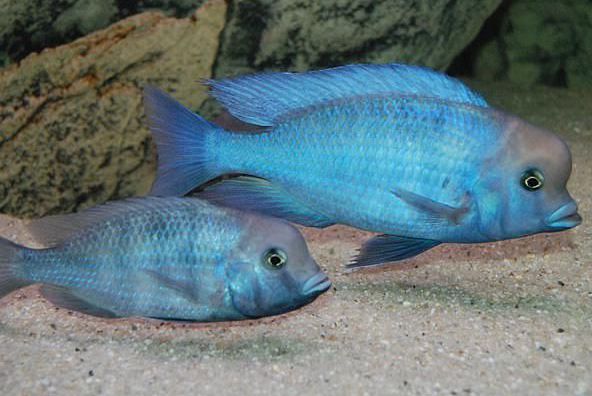Introduction
Cyrtocara moorii, also known in the hobby as Haplochromis moorii or the Malawi Blue Dolphin, was named after the collector of the type material, J. E. S. Moore. Moorii was first described in 1902, and was first exported out of Africa in 1968. It gained the nickname “blue dolphin” due to its pronounced forehead (called a nuchal hump) and lips and overall resemblence to dolphins.

Moorii, known natively as “Chinkongo” and “Kabale,” are very peaceful cichlids and tend to do quite well with other rift lake fish. I have a 1-male, 4-female group that reside with other haps, peacocks, and mbuna. The moorii almost seem to have a calming effect on the tank.
Blue dolphins are notoriously slow-growers, and can take a year plus to go from fry to sexual maturity (around 4-5 inches). Given the time, males can reach a full 8 inches or more, with females maxing out around 6-7 inches. The nuchal hump begins to develop at around 3 inches, but might not reach prominence until 6+”.
Moorii are also known as sand divers. If danger is near, they will sometimes dive down into the sandy substrate! I learned this the hard way one night. I was trying to catch a female, and she completely disappeared. Gone. After 10 minutes of searching and removing rocks, I noticed a tiny eye staring at me from under the sand. I poked it with the net, and pow! The moorii shot out of the sand!
Sexing
Sexing can be quite difficult with moorii, as they are a monomorphic species (males and females look the same). Males tend to be somewhat larger than females, but unless your fish are the exact same age, it can be difficult to use size as an indicator.
Habitat
Due to their size, I would recommend a 75-gallon tank as a minimum. I have my group in a 55, but they are still quite young. An 8-inch male will need some open space to swim, and a 125-gallon tank is more appropriate for a fish of that size. In the wild, they are found in open, sandy environments.
Moorii show little aggression towards tank mates. Every so often I’ll see my dominant male nudge a female out of his way, but I have never seen the all-out blitz that some super aggressive mbuna have shown. Having more than 1 adult moorii male in a tank will usually stir up some aggression, so stick with the 1 male, 2+ female standard if possible.
Feeding
In the wild, the carnivorous moorii have developed a unique feeding behavior. They follow closely behind Fossorochromis rostratus and similar substrate diggers and snatch up tiny invertibrates and food pieces that are kicked up in the sand while the rostratus hunt.
Since that is a nearly impossible senario for an aquarium, I’d recommend a mixture of cichlid pellets, flakes, and frozen foods. They can be a bit picky when it comes to pellets, but mine take New Life Spectrum without complaint. Of course, what fish doesn’t? A protein-heavy flake will also do the job. Mine seem to like spirulina flakes as well.
Breeding
Moorii are a fairly standard mouthbrooder. They will search for a flat surface or will dig a sand crater in the open areas. Males turn a deep blue with a nearly black outline when showing off for females. After spawning, females will hold the standard 21-25 days. Brood size will depend greatly on the female’s size. They’ll breed at 3-4 inches, but will only hold 15-25 at that size. Full-grown adults can hold three times that amount!
Females are known to be quite unreliable mothers, and will spit their eggs out at with the slightest of startling.
Availability
Moorii are a fairly common Malawian Hap in the hobby, and can be found locally often times. They are aren’t quite as common in Lake Malawi, and wild caught specimens could easily run you $25-35 each.
Retail price
Malawi dolphins can usually be had at a LFS for about $10-15 for a 2″ fish. Due to the length of time to fully develop and their popularity, adults can be very expensive. Local breeders sell them for much less, as is usually the case with most fish. I’ve seen breeders sell them for $2-3 per inch, but deals are always out there. I got my group of five for $10 total, and all of the fish were 2-3 inches already.
Leave a Reply